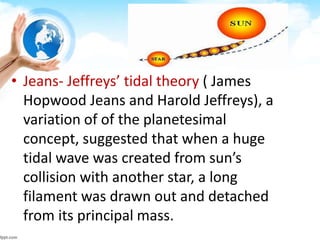The Origin of the Solar System
- 1. The Origin of the Solar System What made it possible for the planets to become as big as they are?
- 3. • Model- is a representation of an idea, an object, or even a process that is used to describe and explain phenomena that cannot be experienced directly.
- 4. Two popular model about Solar System • Geocentric model-Claudius Ptolemy’s, which states that Earth is at the center of the Solar System. • Heliocentric model- Nicholas Copernicus, states that the sun is the center of the Solar System.
- 5. Scientific Theories that explain the origin of the Solar System • Theories build up from the idea of Angular momentum, which is the quantity of rotation of a body, which is the product of its moment of inertia and its angular velocity 1.Nebular Hypothesis- Immanuel Kant and Pierre-Simon Laplace, were the first to propose the earliest theory of how the Solar system is originated.
- 6. • Kant-Laplace Nebular Hypothesis presumes that the solar system began as a cloud of dispersed interstellar gas called nebula.
- 7. • 2. Planetesimal and tidal theories- Thomas Chrowder Chamberlin and Forest Ray Moulton worked on the Kant-Laplace nebular hypothesis, which became the Chamberlin- Moulton planetesimal hypothesis. • Planetesimals- smaller masses quickly cooled and became numerous smaller bodies. When star passed close enough to the sun, creating huge tides and causing materials to be ejected.
- 8. • Jeans- Jeffreys’ tidal theory ( James Hopwood Jeans and Harold Jeffreys), a variation of of the planetesimal concept, suggested that when a huge tidal wave was created from sun’s collision with another star, a long filament was drawn out and detached from its principal mass.
- 9. • 3. Protoplanet Theory- is modified version of the nebular hypothesis, which incorporates modern knowledge of matter formed indepently by astronomers Gerard Kuiper and Carl von Weizasacker. The dense area of nebula and the gaseous matter surrounding it ceased to rotate uniformly.Under the influence of turbulence and tidal action, the nebula broke into whirpools of gas within a rotating mass called protoplanet.
- 11. Life on Earth • Habitable zone- Earth’s distance from the sun, allows Earth to hold water. • Possible sources of water on Earth 1. Through volcanism 2. Water from the icy meteors Earth necessary to support life sources 1. From earth 2. And from the sun
- 12. Motions of Earth • Solar system model places the sun at the center with terrestrial and Jovian planet moving around it. • Earth rotation is the amount of time that it takes to run around once on its axis. • An Axis is an imaginary line about which the body rotates. • Earth’ axis is tilted 23.5 degress.
- 13. • There are 2 different kinds of rotation: 1. The amount it takes for Earth to turn on its axis known as the sidereal day 2. And the amount of time it takes for the sun to return to the same spot called solar day. Earth rotates on its axis in 23 hrs, 56 minutes, and 49.09 seconds.
- 14. Energy received through Solar Radiation 1. Biologically, chemical energy transferred from one level of the trophic level to the next. Photosynthetic organisms capable of harnessing and converting radiant to chemical energy. 2. Physiologically, all organisms responds to stimulus( Melanin-brown-black pigment in the skin) 3. Meteorologically, weather and climate is driven by solar radiation. Season-results in changes in weather, ecology, and daytime
- 15. EARTH’S SYSTEM Earth is composed of a system of interacting zones.
- 18. Earth as a Closed System The amount of matter within a closed system is fixed. The resources used can never be regenerated, and the waste produced cannot be disposed. Once used up, these mineral resources transform into something else.

























